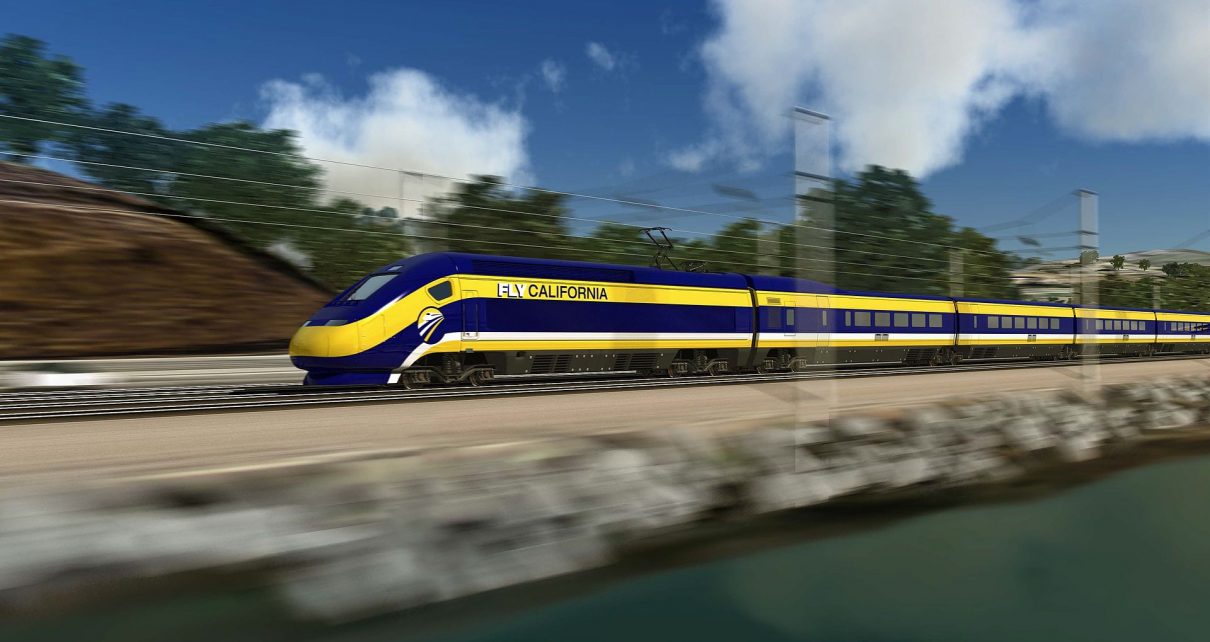
High Speed Rail train, artists rendering. (Photo: CHSRA.ca.gov)
Green Train, But No Green Money
Even ESG investors aren’t stupid enough to put money in High Speed Rail
By Thomas Buckley, December 18, 2023 2:45 am
When the bond was passed 1100 years ago to create California’s high speed rail project/grifty thingy/whatever, voters were told a number of things like where it would go, when it would be done, and how much it would cost.
All lies, of course, but one other lie stands out: the lie that private investment will clamor to get involved, this will be a true public/private partnership, hey, look at Europe and Japan – they have private money in their trains so of course it will happen in California!
As the San Diego Union-Tribune editorial board has recently reminded everyone, the backers of the measure explicitly knew this was false and intentionally hid this fact from the public until six days after the bond measure vote:
“…few are aware that before 53 percent of voters backed Proposition 1A in 2008 based on the rosiest of projections, state officials already knew it was likely doomed — but kept the information hidden. The rail authority had promised to release a business plan by Oct. 1, 2008, that was expected to back the claims of Gov. Arnold Schwarzenegger and Democratic leaders that the project was a sure winner akin to successful bullet train programs in Europe and Asia. The plan was never released, allegedly because of staffing issues. But just after the election, it emerged that rail authority analysts had warned the project would never attract enough private investors to pan out. That’s because unlike projects such investors had backed elsewhere, Proposition 1A banned taxpayer subsidies if costs exceeded revenues — a crucial detail.”
A personal aside – I was serving on the Southern California Association of Governments’ Regional Council around the time of the bond vote and I can attest that, while most of the electeds who backed the train (I did not) did so in good faith, various and sundry transportation staffers and experts and consultants and such hovering around the project also knew – but for a different reason – that it was almost assuredly doomed from the beginning. The ridership projections meant running a system at practically subway intervals (miss the 3:30 from San Fran to LA? Just take the 3:41! – that’s still pretty much the case, by the way) and the cost figures were malpractice wrong – $33 billion gets you from Riverside to San Diego, probably, not from San Diego to LA to SF to Sacramento.
Once it passed, “in the know” types who had supported the project whisper/smirked they had done so because they knew it would fail, potentially freeing up all that bond money for other transportation uses – what, you think the people of California would get it back? In fact, some already was re-appropriated, with “high speed rail” money having already been spent on local grade separation, etc. projects to – giggle – “ensure local connectivity” to the eventual project.
As to it being a public/private effort, that was claimed to attract the voters – period. Maybe some folks actually believed that when they originally put pen to paper in the long long ago, but they knew weeks if not months in advance of the vote that that was a false hope.
And while not at all claiming to be a financial whiz – just ask my credit card companies and relatives – even I noticed a basic flaw in the argument and I mentioned it to people and was met with, um, can a blank stare be terrified, too?
Private companies like to make money. Private companies invest in things that will give them a decent and/or reliable return on investment. Private companies look at investment possibilities and decide to say yes to some and no to others, based on projected return.
For this purpose, let’s put that return at, say, 6% – not quite S&P in most recent years, but better than grocery store margins (they really are incredibly tight.)
So the private folks would want 6%, but since the state could borrow at 3-4% to build it, a public/private partnership would actually increase the cost of the project by that difference, which would be in the billions.
So why the sales pitch for something that was both almost assuredly never going to happen and would add to the cost even if it did? Because the idea of a “public private partnership” was focused group and it made people more likely to vote yes. Same with the $33 billion price – let’s just say that was not entirely based on engineering figures and was arrived at in part because it was palatable to voters.
But I digress.
The high speed rail people continue to publicly say, state, aver, imply, claim, hint, and declare that the project will attract private investment.
And when dastardly naysayers point out inconvenient truths (sorry, Mr. Gore) that the project is a failure wrapped in a fiasco, wrapped in a flop and folded into felonious(?) financial finagling they are shot down immediately with: it’s green! How dare you burn the planet down, doncha know we’re trying to save your life, you troglodyte?!
It’s Green! It will cut carbon! When cows stand next to the tracks they won’t fart! So, sure it might cost aa bit more than we hoped but we’re doing it for the right reasons – Rome didn’t fall in a day!
Which leads to a simple question: if it’s green and if it will make money, where are the green investors?
With literally trillions of dollars floating in the ESG ether, why has none of it directly landed on the greenest thing going, or about to go, or maybe go a lot later, or maybe go just from Shafter to Merced?
ESG investors may be morally bankrupt, ethically challenged, and part of the global restructuring away from representative democracy to socialite socialist statism, but they are not stupid.
Giants in “environmental, social, and corporate governance” investing like BlackRock, MorganStanley, Microsoft, MasterCard have not dropped a dime on the project (actually, maybe by not dropping a dime they have “dropped a dime” on it…hmm)
What about truly woke schools with scads of money, schools that teach that cars are evil? The endowments of Stanford and Harvard are nowhere to be seen.
Well, what about closer to home, you know, progressive people who really understand the importance of the project? Not a dollar from Silicon Valley or Hollywood.
Okay, but that’s private money – green public money would surely put up funds to partner with a green public project, right?
The state pension system CalPers – which has legislature-imposed climate-related investing guidelines, has $360 billion dollars under management and can move global markets by itself, its sister agency CalStrs (teachers retirement) has another $255 billion or so, and the University of California system has another $150 billion.
That’s about $750 billion dollars right there – and exactly zero of it is invested in the high speed rail project.
And that is all you need to know about the future of high speed rail in California.
Note – I thought about it, but decided not to bother to contact any of the groups mentioned above. Why? Because – if they even bothered to respond to what would be the tricky, embarrassing question of “Why haven’t you put your money where you mouth is?” – all of the answers would have been variations on the following theme: “We support the efforts of California’s high speed rail project and are confident it will be a great success. We are continually re-examining our investment decisions and strategies and are open to considering a partnership at an appropriate time in the future.”
Did I mention I also do PR?
- Do Cops Trust UCLA? Not So Much… - May 9, 2024
- Educators Quizzed by Congress About Growing Antisemitism in Public Schools - May 9, 2024
- Acting Labor Secretary Julie Su Facing Heat For Pandemic Fraud - May 9, 2024





This is a typical California catastrophe – (like the safe streets and schools act) – that is created when our elected leaders lie to us. And now we seem to be stuck with this tar baby because our voting population naively believed in 2008 what our elected grifters tell them. And like most publicly funded grift, there is no way to stop the teenaged monster, short of a cow on the tracks at high noon.
I suppose we could pass a law making it illegal to lie to voters. LoL
We both know that’s never gonna happen. It is just another pipe dream like high-speed rail. The best we can do is see who’s behind the proposition, who’s supporting it. If it’s the public employee and labor unions and the governor who’s behind the proposition, then it’s an automatic “NO” vote.
Don’t blame US – we voted NO on the boondoggle, because we knew it was a pipe-dream that was full of BS….
(Dominion probably flipped our vote during tabulation to YES, however…until that cancer on the California voting system is excised, NO ballot is worth the paper it’s printed on….)
Everyone seems to think Californians actually voted for this. Did we learn nothing from the 2020 election? Has anyone else noticed that these boondoggle propositions always seem to pass by 52-56%? California is not a blue state. It is occupied territory.
But so is the state of Oregon.